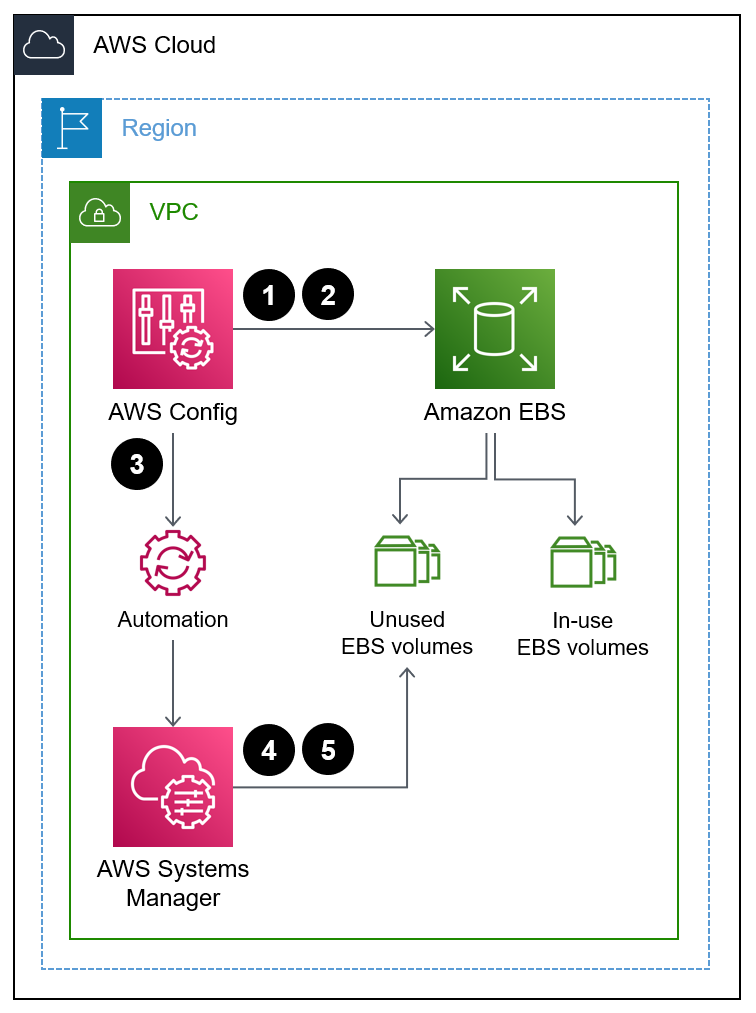Delete unused Amazon EBS volumes by using AWS Config and AWS Systems Manager
Sankar Sangubotla, Amazon Web Services
Summary
The lifecycle of an Amazon Elastic Block Store (Amazon EBS) volume is typically independent from the lifecycle of the Amazon Elastic Compute Cloud (Amazon EC2) instance to which it is attached. Unless you select Delete on Termination option at the time of launch, terminating the Amazon EC2 instance detaches the Amazon EBS volume but doesn’t delete it. Especially in development and testing environments where it’s common to launch and terminate Amazon EC2 instances, this can result in a large number of unutilized Amazon EBS volumes. Amazon EBS volumes accrue charges in your AWS account, regardless of whether they’re being used. Deleting these volumes can help you optimize costs for your AWS accounts. In addition, deleting unused Amazon EBS volumes is a security best practice to prevent access to any unused, potentially sensitive, data in those volumes.
AWS Config can help you manually or automatically remediate noncompliant resources. This pattern describes how to configure an AWS Config rule and automatic remediation action that deletes unused Amazon EBS volumes in the account. The remediation action is a predefined runbook for Automation, a capability of AWS Systems Manager. You can configure the runbook to create a snapshot of the volume before deleting it.
Prerequisites and limitations
Prerequisites
An active AWS account.
AWS Identity and Access Management (IAM) permissions to run the
AWSConfigRemediation-DeleteUnusedEBSVolumerunbook for Automation, a capability of Systems Manager. For more information, see Required IAM permissions in AWSConfigRemediation-DeleteUnusedEBSVolume.One or more unused Amazon EBS volumes.
Limitations
The unused Amazon EBS volumes must be in the
availablestate.
Architecture
Target architecture

The AWS Config rule evaluates the Amazon EBS volumes.
The rule returns a list of compliant and noncompliant resources. Amazon EBS volumes that are in the
availablestate, which are unused volumes, are determined to be noncompliant.AWS Config automatically starts the Automation runbook.
If configured, Systems Manager creates snapshots of the unused volumes before deleting them.
Systems Manager deletes the unused Amazon EBS volumes.
Automation and scale
You can apply this solution across all accounts in your organization. For more information, see Managing rules across all accounts in your organization in the AWS Config documentation.
Tools
AWS Config provides a detailed view of the resources in your AWS account and how they’re configured. It helps you identify how resources are related to one another and how their configurations have changed over time.
AWS Systems Manager helps you manage your applications and infrastructure running in the AWS Cloud. It simplifies application and resource management, shortens the time to detect and resolve operational problems, and helps you manage your AWS resources securely at scale.
AWS Systems Manager Automation simplifies common maintenance, deployment, and remediation tasks for many AWS services.
Epics
| Task | Description | Skills required |
|---|---|---|
Create a role for the Automation runbook. | Create a role called | AWS systems administrator |
Turn on the AWS Config recorder. | Follow the instructions in Setting Up AWS Config with the Console in the AWS Config documentation to make sure that AWS Config is running and it is configured to record Amazon EBS volumes. | AWS systems administrator |
Run the rule. |
| AWS systems administrator |
| Task | Description | Skills required |
|---|---|---|
Add the automatic remediation action. |
| AWS systems administrator |
Test the automatic remediation for the AWS Config rule. |
| AWS systems administrator |
Troubleshooting
| Issue | Solution |
|---|---|
AWS Config doesn’t accurately reflect the resource state. | Sometimes, AWS Config doesn’t update the state of the resources. Turn the recorder off and then turn it back on again on the AWS Config Settings page. The recorder captures the state of the resources. For newly created or deleted resources, it might take some time for the recorder to reflect the current state. For more information about Amazon EBS volume states, see Volume states in the Amazon EBS documentation. |